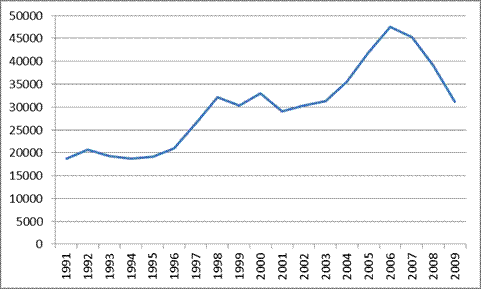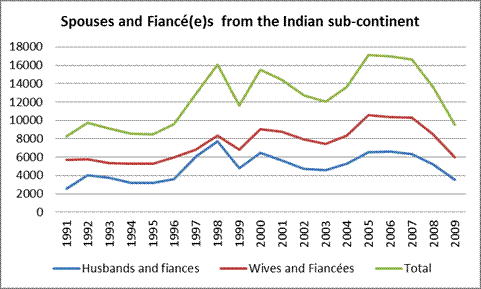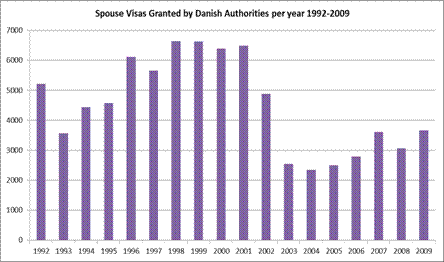Marriage to a Foreign Partner
6 June, 2011
Summary
- This briefing paper considers the number of spouses and fiancé(e)s given leave to enter the UK and the current immigration rules governing their entry and settlement[1]. It suggests the following policy changes :
- Reinstatement of full interviews, especially in cases or countries of concern, with specific guidance in the Immigration Rules designed to detect those marriages undertaken under pressure. The focus should be on those countries with a low average age of applicant for marriage visas. (Paragraph 17).
- The couple should be required to demonstrate that they had been in the same country and had known and met one another over a period of several months. (Paragraph 18).
- A minimum salary of the minimum wage plus 10% for each dependant. Income from benefits or family should be excluded (Paragraph 20).
- The English language level should be revised to A2 (Paragraph 21).
- All spouses should wait 5 years before being granted Indefinite Leave to Remain (Paragraph 22).
- There should be more effective checks that the marriage is still subsisting at the 5 year point to discourage sham marriages (Paragraph 23).
- A sponsor who divorces should not be allowed to sponsor a further overseas spouse for a period of five years (Paragraph 24).
- The definition of “family” in the rules governing family visits should be tightened and taxpayer subsidy for appeals should cease (Paragraph 25).
Introduction
2. The virtual abandonment of interviews for marriage visas leaves the door wide open for marriages where one or both parties have come under pressure to marry against their will. It also fails to ensure that the spouse will not become a burden on public funds and that the spouse has the language skills necessary to integrate into wider society.
Numbers
3. There are two measures; the number of visas issued and the number of spouses granted leave to enter the UK. The numbers given leave to enter the UK as spouses grew steadily from 21,000 in 1992 to 47,000 in 2006 before declining to 31,000 in 2009. This trend is also reflected in the number of visas issued. There isn’t a simple explanation for the recent decline: during a recession the reduced employment prospects and general economic insecurity may act as a deterrent while the raising of the minimum age to 21 from November 2008 is very likely to have contributed. Since 2004 these numbers have included civil and unmarried partners, which in 2009 consisted of 2500 migrants or 8% of the total. A foreign spouse is able to bring dependent children with them. The numbers are significant; for example 5,500 children were admitted in this way in 2009[2].
Figure 1: Spouses and Fiancé (e)s given leave to enter the UK[3]

Origins of foreign Spouses and fiancé(e)s
4. Tables 2 and 3 below show the top ten countries of origin[4] for spouses and fiancé(e)s in 2009.
Table 2: Top ten countries of origin for husbands or fiancés in 2009
| Country | Husband or Fiance |
| Pakistan | 1920 |
| India | 1070 |
| Bangladesh | 585 |
| Turkey | 465 |
| USA | 430 |
| Nigeria | 425 |
| South Africa | 325 |
| Jamaica | 280 |
| Australia | 270 |
| Philippines | 230 |
Table 3: Top ten countries of origin for wives or fiancées
| Country | Wife or Fiancee |
| Pakistan | 2960 |
| India | 2050 |
| Thailand | 1250 |
| USA | 1180 |
| Bangladesh | 945 |
| Iraq | 830 |
| China (inc. Taiwan) | 765 |
| Philippines | 640 |
| Afganistan | 620 |
| South Africa | 455 |
The top two countries for both men and women are Pakistan and India. Bangladesh supplies the third largest number of husbands and fifth largest number of wives. Together they accounted for nearly a third of all spouses and fiancées in 2009.
5. The Indian-sub continent has consistently been the region that supplies the largest proportion of spouses. Nearly 50% of men and just fewer than 40% of women in the last ten years came from the Indian sub-continent.
Figure 2:

6. The sharp rise in male spouses after 1997 was due to the abolition of the “primary purpose” rule that required that entry clearance to the UK for a fiancé(e) or spouse would be refused unless the Entry Clearance Officer was satisfied “that it is not the Primary Purpose of the intended marriage to obtain admission to the UK”.
7. Recently Africa has grown in significance as a source of spouses. In 1992 it supplied 1580 or 7% spouses. By 2009 Africa was the source of 5500 or (18%) of spouses.
8. There are three ways in which a person may enter the UK as a spouse/fiancé(e):
A six month visa for a fiancé(e).
A person may apply for a visa to enter the UK for six months if they are the fiancé(e) of a British citizen or of a person who is settled in the UK. During those six months they are expected to marry and are not entitled to work. Once married, they can then apply for further leave to remain (FLR), which, if granted, extends the leave to remain for a further two years This visa will allow the individual to work in the UK and apply for Indefinite Leave to Remain (ILR). The applicants must show that the marriage is still subsisting and that they intend to continue living together as a married couple[5].
A 2 year visa for a spouse.
A person married to a British citizen or to someone who is settled in the UK can enter by being given Leave To Remain (LTR) for two years, during which time they can work. After two years, the visa holder can apply for ILR as long as the marriage is still subsisting and they intend to continue living as a married couple[6].
Indefinite leave to enter for a spouse of 4 years.
A person who has lived for four years overseas with a spouse who is a British citizen or settled foreign national, may be granted indefinite leave to enter (ILE)[7]. This amounts to ILR but is less than 5% of the total spouse visa grants in 2009 and is in addition to the numbers contained in paragraph 3.
Visa Requirements
9. As set out in Section 8 paragraph 281 of the Immigration Rules, the decision to grant entry is based on consideration of a number of factors. These can be summarised as:
- Language
A person has to demonstrate ability to speak and understand English in one of three ways:
- By passing English to CEFR Level A1, the lowest available level;
- By being a national of a majority English-speaking country;
- By completing a qualification at the equivalent level of a UK Bachelor’s degree taught in English.
- The applicants must have met each other;
- each of the parties must intend to live permanently with the other as husband and wife or civil partner;
- there must be adequate accommodation for the parties and any dependants without recourse to public funds in accommodation which they own or occupy exclusively; and
- the parties must be able to maintain themselves and any dependants adequately without recourse to public funds
10. An applicant is only entitled to switch to remaining in the UK on the basis of marriage if already granted more than six months leave to remain, thus precluding the possibility of an individual switching to a marriage visa from a visitor visa[8].
11. An age requirement that both parties must be 21 has been successfully challenged in the courts as an infringement of article 8 of the European Convention of Human Rights[9]. The Home Office are intending to appeal. If they lose, the minimum age will revert to 18[10].
Appraisal of Visa Requirements
12. The Language level A1 is the lowest level of the CEFR framework; it requires only a very basic level using simple everyday phrases to communicate.
13. The requirement for a previous meeting can be satisfied by meeting on the day of the wedding ceremony, if this takes place abroad.
14. In theory there must be adequate accommodation which the spouses and any dependants will occupy exclusively. If the accommodation is shared, it must be shown that one part of it, namely a bedroom, is for the sole use of the couple. No inspection is required; a letter purporting to be from a landlord can suffice. In practice, it is not possible for the UKBA to check whether the couple and their dependants are living as a family unit exclusively in a property, whether there is sufficient room for the entire family, and whether the couple are living as husband and wife or civil partners.
15. The Home Office were unable to state how many spouse visas have been refused for failing to supply evidence of maintenance without recourse to public funds. A full list of public funds is given in Annex A. The application form[11] requires evidence of income such as payslips and tax returns. Income can include benefits. Income from other sources such as friends and family can also be included and is obviously open to abuse. In theory, the arrival of a spouse should not increase the entitlement benefits but there are no effective checks.
16. All these factors are supposed to be considered before an entry clearance visa is issued. However, interviews with Entry Clearance Officers have been virtually abandoned. The process has therefore become little more than a box ticking exercise. An individual may now be granted entry clearance, further leave to remain and finally indefinite leave to remain in the UK without ever meeting an immigration official.
Proposed Changes
17. The immigration rules should be strengthened by requiring full interviews in cases or countries of concern at which the following matters which should be specified in the Immigration Rules, should be taken into account. Interviews could be targeted at those countries with a low average age of marriage:- the length of time that the parties to the marriage or civil partnership had known each other;
- any cultural, religious, educational, language or age differences between the parties;
- any indications that undue pressure had been exerted on either party to enter into marriage or civil partnership from family members or others;
- any evidence that money or property had changed hands between the families in the course of arranging the marriage;
- whether both parties had genuinely consented to the marriage or civil partnership;
- whether there had been any discussion between the parties concerning the practicalities of living together in the United Kingdom;
- whether it was in accordance with the custom of the community concerned that the person seeking leave to enter should move to the family of the other party to the marriage or civil partnership.
18. Particular consideration should be given to the length of time both parties have known each other to ensure that the marriage is as a result of a genuine relationship. We therefore propose that the couple should be required to demonstrate that they had been in the same country and had known and met one another regularly over a period of several months.
19. It is important to retain the age limit of 21, if the courts permit, in order to protect the potential spouse. When the age requirements were raised in Denmark from 18 to 24 in 2002 numbers fell by 65%, from 6,500 in 2001 to 2,340 in 2003 (See Annex B). Netherlands also has an age limit of 21 where one party is subject to immigration control. Denmark and the Netherlands are both, of course, subject to the European Convention on Human Rights.
20. To ensure that the applicants are able to support their spouses and any dependants, a minimum income should be imposed. The applicant and the spouse should have a joint income equivalent to a full time job at the minimum wage plus 10% for every extra dependant, a requirement that is similar to the French system[12]. Elderly dependants should be required to take out private health insurance before admission.
21. In order to help spouses integrate into the community we propose that the language requirement be raised to A2 – “conveys and understands only general meaning in very familiar situation”. This is the minimum to allow the spouse to communicate in social situations and to be able to read and understand the basic points of simple texts[13].
22. The spouse of an EU national has to wait five years from entry before being granted ILR. The time required to qualify for ILR for the spouse of a UK national or a foreigner with settlement rights in the UK should also be lengthened to five years. This would also align the qualifying period with those who apply for settlement through the work permit routes. This change would have no negative impact on genuine marriages since leave to remain continues so long as the marriage is subsisting.
23. To discourage sham marriages there should be more effective checks at the five year point to ensure that the marriage is still subsisting.
24. Someone who has sponsored an overseas spouse should, in the event of a divorce, not be permitted to sponsor a second overseas spouse until five years have elapsed from the date of the divorce.
25. The present definition of family for the purpose of family visits is extraordinarily widely drawn and can only have the effect of encouraging arranged marriages with an overseas partner[14]. The scope should be narrowed to close family and the taxpayer should no longer subsidise appeals.
Conclusion
26. The measures outlined above would help ensure that a marriage involving an overseas national subject to immigration control was genuine and not undertaken as a result of pressure being applied to one or both parties. They would also ensure that the marriage could be supported without placing additional burdens on public resources. Furthermore the spouse would have a better grasp of English to help with integration into wider society.
Annex A
The following count as Public funds for immigration purposes:
- income-based jobseeker's allowance;
- income support;
- child tax credit;
- working tax credit;
- a social fund payment;
- child benefit;
- housing benefit;
- council tax benefit;
- state pension credit;
- attendance allowance;
- severe disablement allowance;
- carer's allowance;
- disability living allowance;
- an allocation of local authority housing;
- local authority homelessness assistance;
- health in pregnancy grant; and
- income-related employment and support allowance.
Annex B
Figure 3 below shows the number of spouse visas granted to enter Denmark each year from 1992 to 2009. In 2002 the age limit for the party subject to immigration control was raised from 18 to 24[15].
Figure 3
:
Footnotes
- Does not include those settled on arrival see paragraph 8 section iii.
- Control of Immigration 2009 supplementary table 1f. Children granted leave to enter for a probationary period as dependants of person settled
- Includes unmarried and proposed civil partners since 2004
- As determined by grants of leave to enter
- Applicant must also pass the Knowledge of Life in the UK or an ESOL test
- ibid
- Show -6 more...
- Does not include those settled on arrival see paragraph 8 section iii.
- Control of Immigration 2009 supplementary table 1f. Children granted leave to enter for a probationary period as dependants of person settled
- Includes unmarried and proposed civil partners since 2004
- As determined by grants of leave to enter
- Applicant must also pass the Knowledge of Life in the UK or an ESOL test
- ibid
- ibid
- Student Visitor visas for those studying English can now be extended to a maximum of 11 months.
- http://www.bailii.org/ew/cases/EWCA/Civ/2010/1482.html
- Subject to the Government making a change to the immigration rules
- VAF4A, http://www.ukvisas.gov.uk/en/howtoapply/vafs
- Kofman, Rogoz and Levy, “Family Migration Policies in France”, January 2010
- The current language requirement is for speaking and listening not reading and writing
- Migration Watch Briefing Paper No 11.19
- Statistical Overview – Migration and Asylum 2001-2009, Danish Immigration Service
